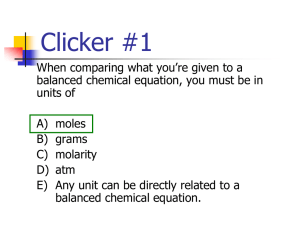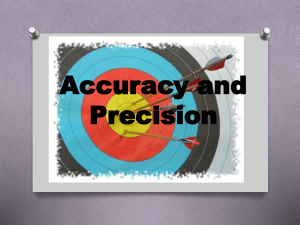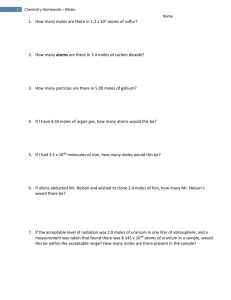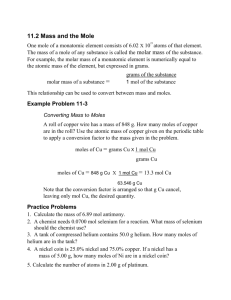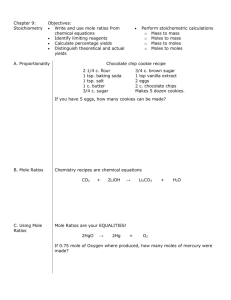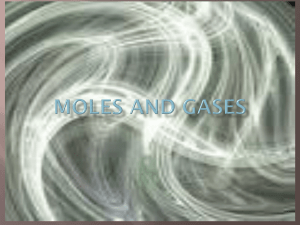Unit 3 Booklet
advertisement
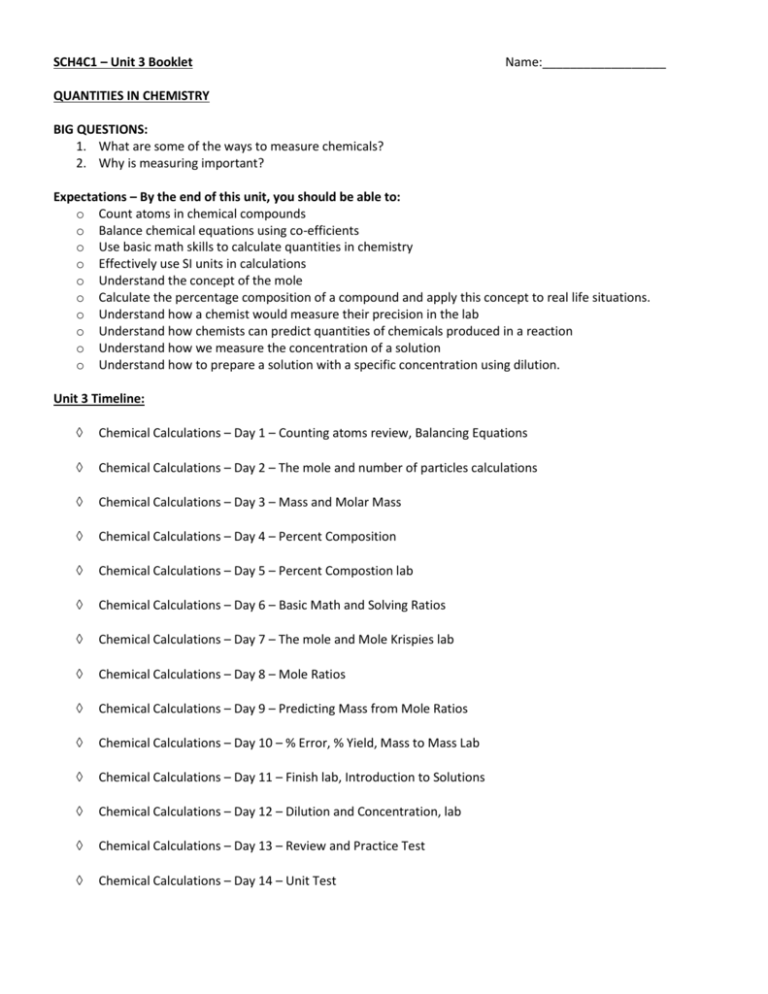
SCH4C1 – Unit 3 Booklet Name:__________________ QUANTITIES IN CHEMISTRY BIG QUESTIONS: 1. What are some of the ways to measure chemicals? 2. Why is measuring important? Expectations – By the end of this unit, you should be able to: o Count atoms in chemical compounds o Balance chemical equations using co-efficients o Use basic math skills to calculate quantities in chemistry o Effectively use SI units in calculations o Understand the concept of the mole o Calculate the percentage composition of a compound and apply this concept to real life situations. o Understand how a chemist would measure their precision in the lab o Understand how chemists can predict quantities of chemicals produced in a reaction o Understand how we measure the concentration of a solution o Understand how to prepare a solution with a specific concentration using dilution. Unit 3 Timeline: Chemical Calculations – Day 1 – Counting atoms review, Balancing Equations Chemical Calculations – Day 2 – The mole and number of particles calculations Chemical Calculations – Day 3 – Mass and Molar Mass Chemical Calculations – Day 4 – Percent Composition Chemical Calculations – Day 5 – Percent Compostion lab Chemical Calculations – Day 6 – Basic Math and Solving Ratios Chemical Calculations – Day 7 – The mole and Mole Krispies lab Chemical Calculations – Day 8 – Mole Ratios Chemical Calculations – Day 9 – Predicting Mass from Mole Ratios Chemical Calculations – Day 10 – % Error, % Yield, Mass to Mass Lab Chemical Calculations – Day 11 – Finish lab, Introduction to Solutions Chemical Calculations – Day 12 – Dilution and Concentration, lab Chemical Calculations – Day 13 – Review and Practice Test Chemical Calculations – Day 14 – Unit Test SCH4C1 – Unit 3 – Chemical Calculations: Name:_______________________________ Counting Atoms: Subscripts: KNO3 #K_________ #N_________ #O________ Brackets: Mg(OH)2 # Mg_______ #O_________ #H_________ Co-Efficients: 2CO2 #C_________ #O_________ Try these: 2Mg(OH)2 BaNO3 Mg Ba O N H O 4PbCl4 Na2Cr2O7 Pb Na Cl Cr O 3H2SO4 5NH3 H N S H O Balancing Equations Skeleton equations just show the ________________ and ___________________ molecules. Example: BUT In chemical equations, the number of atoms on the reactants side of a reaction has to be __________________to the number of atoms on the products side. We need to __________________ the equation. Most skeleton equations are not balanced. We do this by adding whole ____________________ to either side of a reaction. These are shown as ________________________ in the equation. Examples: Reactants Products N H __________N2 + ___________H2 ______________NH3 Reactants Products H _________H2 + ____________O2 ______________H2O O Reactants Products Na _______ Na + _______ N2 _______ Na3N Try These: 1. _______ Al + ________ Fe3N2 2. _______ ZnS + ________AlP 3. ______ NaClO3 _________ AlN + ________ Fe _______ Zn3P2 + ________Al2S3 ________ NaCl + _________ O2 N 4. ________ Ag2S ________ Ag + _______S8 5. _______ Br2 + _______KI 6. _______ C3H6 + _______ O2 _______ H2O + ________CO2 7. ________ AgNO3 + ________ CaI2 ________ AgI + ________Ca(NO3)2 8. ______ Ba(NO3)2 + _______Na2S ________ BaS + ________NaNO3 9. __________Al(NO3)3 + ________Mg _________KBr + ________ I2 ________Mg(NO3)2 + _________ Al *challenge problem* Chemical Quantities: Number of Particles: Sometimes it is useful to be able to count the number of ___________ or _________________ in a sample of a chemical. Remember that particles are very small, so these numbers will be very large. We use the symbol ______ to represent number of particles in a calculation. The Mole: The mole is a useful way of measuring chemicals. One mole represents a set number of particles, and does not depend on what the substance is. In calculations the symbol for the number of moles is ________. Analogy: 12 donuts is equal to one dozen. 602,200,000,000,000,000,000,000 particles are equal to one mole. The big number above is called ____________________________ _________________. An easier way to write this is in scientific notation. It’s ____________________. On your calculator, you need to use the exponent button to do this (ask me if you need to know how to do this on your calculator!). Moles, particles and Avogadro’s number are related with the following triangle, which you can use to do calculate one of the three quantities (if you know the other two). Examples: If there are 5.5x1024 molecules of beryllium in a sample, how many moles are there? If there are 3.45 moles of helium gas in a balloon, how many helium atoms are there in the balloon? Try these: How many moles of Uranium are in a 3.45x1022 atom sample? How many atoms are in 0.15 moles of lithium? Mass: Mass is easy to measure in class using a ________________ (scale). We measure mass in _______ and the symbol we will use in calculations is _________. Molar Mass: The molar mass of an atom is found ______________________________________________________________. It represents the ____________ of one mole of the substance. The symbol for molar mass in calculations is _________ and it is measured in _____________. Examples: M of Carbon= _______________ M of Lead = ____________ M of Uranium = _______________ You can also find the molar mass of a compound by _________________________________________________. Examples: M of CO2 = _________________ M of H2O = _____________________ The mass, molar mass, and number of moles are all related by the following triangle which allows you to calculate one quantity if you know the other two. Examples: 1. How many moles of potassium are in a 12 gram sample? 2. How many grams of U2O5 are in 1.5 moles? Try these! 1. How many moles of NaOH are in a 60 gram sample? 2. How many grams are in 13 moles of O2 gas? Percent Composition: Percent composition: Steps to find the percentage composition by mass of a substance: Example: CO2 1. Find the molar mass of each element individually. 2. Find the molar mass of the whole compound. 3. Divide the element’s M by the compound’s M. You need to do this once for each element. 4. Multiply your results by 100%. 5. Check to make sure that all the percents add up to 100. Try these: 1. Find the percent composition of each element in NaCl. 2. Find the percent composition of each element in BaCl2. Some Basic Math You May Need: Equivalent Ratios: 5 : 16 = 12 : y Examples: If 12 cookies take 2 cups of chocolate chips to make, how many cookies can you make with 3 cups of chocolate chips? If 1 kg of carbon will create 3.5 kg of carbon dioxide, how much carbon dioxide will 15.5 kg of carbon make? Sodium and chlorine react in a 2 : 3.5 ratio by weight. How much sodium do you need to react with 12 kg of chlorine? Try these: 1. Blood contains a ratio of red cells to white cells of 98:2. How many white blood cells are there in a sample that contains 160,000 red blood cells? 2. A sample of rock contains calcium and carbon in a 3.3 : 1 ratio. How much calcium is there if there is 15 kg of carbon? Stoichiometry - Mole Ratios: Balanced chemical equations tell us the _________________ of chemicals in a _____________________. This ratio is by _____________, not by ______________. Example 1: In the reaction 2H2 + O2 2H2O _________ moles of hydrogen react with ___________ mole of oxygen to make _________ moles of water. If you had 3 moles of hydrogen, how many moles of oxygen would you need? How many moles of water could you make? Example 2: In the reaction 4Fe + 3O2 2Fe2O3 What is the mole ratio of Iron : Oxygen? ______________________ What is the mole ratio of Iron: Iron (III) Oxide? ______________________ How many moles of iron reacted to make 4.5 moles of Iron (III) oxide? Try this! 1. Balance this reaction: ________ Ag + ________S2 ___________Ag2S If you had 1.4 moles of silverware in your drawer, and it tarnished (reacted with sulphur), how many moles of silver sulphide would be produced? How many moles of sulphur were pulled from the air? Calculating Moles From Mass – Advanced Stoichiometry You have 22 g of copper. How many moles of copper do you have? (Hint: you need to use the molar mass) You want to react the copper with HCl to make some copper (II) chloride. Balance this equation. _____________Cu + ________________HCl _______________H2 + _______________CuCl2 Use the mole ratio to figure out how many moles of HCl you will need to react with your Copper. Use the molar mass of HCl to figure out how many grams of HCl you will need. Use the mole ratio to figure out how many moles of CuCl2 you can produce. Use the molar mass of CuCl2 to figure out how many grams of CuCl2 you can produce. Limiting Reagents? What Runs Out? We are rarely able to mix chemicals in exact mole ratios. Sometimes you will run out of one chemical. This is called your ______________________ reagent. Example: You are mixing 3 moles of Hydrogen (H2) with 2 moles of Nitrogen (N2) to make ammonia (NH3). Which runs out first? 1. Balance the chemical equation. Do not use the moles given in the question (yet!) __________N2 + ____________H2 _______________NH3 2. Now look at the mole ratio. Which chemical do you have left over? This is called your ___________________ reagent. Example 2: You are mixing 5 moles of Hydrogen (H2) with 4 moles of oxygen (O2) to make water. Which runs out first? 1. Write an equation and balance it. 2. Figure out which will run out from the mole ratio. Try this: You have 4 moles of Aluminum (Al) and 5 moles of chlorine gas (Cl2) and you are trying to make Aluminum chloride (AlCl3). Which runs out first? Concentration and Dilution: Concentration is a measurement of how much of a chemical is in a given __________________. It is usually measured in _________________________________ (mol/L). You can use the following triangle to calculate concentrations, number of moles, or volume when you know the other two. Examples: 1. You have 3 moles of sulphuric acid, and 5 litres of water to mix it in. What will the concentration be of the resulting solution? 2. You want to make a 0.5 mol/L solution of copper chloride. You have 3.5 moles. How much water do you need? 3. You want to make a 1.5 mol/L solution of hydrochloric acid. You have 0.75 L of water. How many moles of HCl do you need? 4. What is the concentration of the solution made by dissolving 100 g of NaCl in 1L of water? (You need to use mass to find moles first!!! Use n=mass/molar mass) Dilution is the process of adding water to a solution. Your ____________________ goes _______________ because the volume goes up and moles stay the same. Examples: 1a) You have 1 L of a 4 mol/L solution. How many moles do you have? b) What is the new concentration if you dilute the solution to 3L? 2a) You have 0.75L of a 0.4 mol/L solution. How many moles do you have? b) What is the new concentration if you dilute the solution to 2L? 3a) You have 1L of a 0.1 mol/L solution . How many moles do you have? b) You boil off some water until there is only 0.2 L remaining. What is the new concentration? (Concentration should go up because volume went down).
